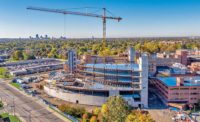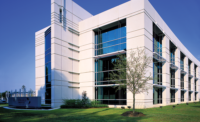When asked the reason behind Baker Triangle’s success, “people” is the consistent answer.
And the Mesquite, Texas-based drywall and plaster and prefabrication contractor has plenty of people, employing more than 1,700 workers across seven Texas offices. Originally founded in 1974 by Bob Baker as two separate companies—Baker Drywall and Triangle Plastering—in 2006, the two entities merged, becoming Baker Triangle.
Measured Growth
Baker Triangle’s regional revenue grew by $30 million in 2017, to a total of $181 million. That growth continues through 2018, as the contractor’s revenue is tracking 30% ahead of last year.
While 2017 was “incredible,” Steve Baker, company chairman, says it could have been even better.
“Although we grew $30 million, it could have easily been $100 million,” he says, citing the firm’s steady approach to expanding its workforce. “We like to serve our [existing] customers instead of expanding into regions where maybe the work is there, but it’s not necessarily our customer or our labor base. We want to be able to handle the needs that our clients might have instead of trying to just grow business.”
Dallas-Fort Worth, which is Baker’s strongest Texas market, was second only to New York City in construction starts in 2017, Baker points out.
“Texas, Oklahoma, Louisiana—our entire region is strong, and we just took advantage of the way the market was moving,” he says.
The contractor’s commitment to its people also bolstered performance, Baker says. For instance, the contractor trains all employees, from the office to the field, thus fostering a culture of continuous improvement.
Partnerships with national construction training companies, involvement with local AGC and ABC chapters and benchmark relationships with non-competing firms from across the country have helped Baker keep up to date with industry standards and best practices.
This longtime commitment has paid off. Two staffers have been with the firm for more than 40 years, another 11 have served for more than 30 years, 43 have been with the firm for more than 20 years and another 208 are on board for more than a decade of service.
“The people are what make Baker Triangle special,” says Bruce Helm, president, Northstar Builders Group. “Their [workers] from upper management to the jobsites have a ‘can-do’ attitude and a solutions mentality.”
Helms adds: “Most contractors can perform well under optimum conditions—it’s when situations are challenging that the truly special ones shine. Baker is one of the special ones.”
A kindred culture has helped Northstar and Baker Triangle achieve success together during their 20-year working relationship, Helm notes.
“[They] take good care of their employees with training, opportunity for promotion and recognition of good work,” he says. “Baker Triangle has been our partner on many of our largest and most complex jobs over the years and have always been a large contributor to the successful outcome on the projects.”
Focus on Prefab
Baker Triangle emphasizes innovation and staying abreast of current practices. An early adopter of BIM, the contractor also was a leader in hiring a full-time safety director—before that became a requirement as it is today, Baker says.
“We’re always looking for something that [will allow] our customers and clients to say nobody else is doing that,” he adds. “For the last 10 years especially, we’ve really been committed to technology and innovation.”
The firm stays at the forefront of BIM and prefabrication in an effort to address clients’ needs, Baker says.
“For the last 10 years especially, we’ve really been committed to technology and innovation.”
– Steve Baker, Chairman, Baker Triangle
In 2013, the company established its prefab division and is performing steady work in prefabricated, exterior, fully finished wall panels, adds Bryan Baker, the company’s CEO—and Steve Baker’s son.
Recently, several projects have utilized the company’s prefab capabilities, such as the Aloft Hotel, which is Baker Triangle’s largest prefab job to date.
The hotel tower’s entire exterior, from levels five to 33, was comprised of 473 prefabricated panels, the largest measuring 14 ft by 40 ft. This included studs, sheathing, waterproofing, exterior insulation and finish systems (EIFS), metal panels and glazing—all of which were installed in a controlled manufacturing environment in Dallas, then driven three hours south to Austin to be installed at night.
“We’ve got a solid backlog of work for the next couple of years, and the market continues to emphasize prefabrication,” Steve Baker says. The contractor’s newly remodeled 80,000-sq-ft prefabrication plant in Richardson, Texas, should accommodate the firm’s production needs for the next five to 10 years.
The company is seeing more progressive owners making a commitment to prefabrication and lean technology and to cutting down on waste.
“Especially in the last 10 years, we’ve really seen a paradigm shift from construction technologies that probably existed for 50 to 100 years” to newer methods, such as robotics or 3D printers, Baker says. “It’s an exciting time.”
The owner of a current project, the Medical City Plano Bed Tower Expansion, wanted prefabrication to be used to deliver 60% of the project’s structure, with a goal of saving 10% in time and cost, explains Preston Pressley, Baker’s vice president of business development and marketing.
“We are going to be prefabricating the entire exterior of the building with a fully finished system, so that’s studs, sheathing, waterproofing, metal panels, EIFS and plaster,” Pressley says.
Five subcontractors—drywall, electrical, mechanical, data and fire/sprinkler—are working together to build prefabricated corridor racks and prefabricated patient room racks together at a prefabrication facility close to the project jobsite.
“We’re putting a lot of the MEP and data and communication systems in these prefabricated racks and installing them prior to any of the walls going up,” Pressley says, adding that each patient room will consist of 60-75% prefabricated components. Installation will begin this month.
Another high-profile project, completed earlier this year, was the Southwest Airlines Flight Training Center. This 367,000-sq-ft facility was built with a fast-paced schedule, and Baker Triangle’s $7-million contract required the installation of high-end ceiling work.
Yet another current project is the Dallas Holocaust Museum, set to open next summer. Baker’s team is responsible for most of the project’s exterior skin and facade.
“For the 55,000-sq-ft facility, Baker Triangle suggested and engineered a prefabricated solution for the unique profile of panels required for the exterior skin,” says Brad Brown, president of Austin Commercial, the general contractor on the project and a firm with which Baker has had a decades-long working relationship.
“This technique and installation minimized errors in the field as well as decreasing the amount of needed craftspeople, scaffolding and equipment typically required for a similar process,” Brown says.
Baker is also installing the drywall and acoustical ceilings, metal panels and shades scope of work on the museum.
Growth Ahead
In 2016, Baker Triangle formally expanded into the Bryan/College Station market, which is bolstered by the presence of Texas A&M. The firm will continue to eye the state’s rapidly growing school construction community.
From 2017 to 2018, Texas voters approved more than $22 billion in bonds funding education projects, Pressley says. “That’s definitely an area that we have noticed and will continue to make sure that we’re in front of the school builders and the ISDs,” he says.
“We’re going to continue to focus on slow growth and continue to improve our performance.”
– Bryan Baker, CEO, Baker Triangle
Those bonds should disperse out into projects over the next five years.
Meanwhile, markets should remain solid for the next two to three years, Baker says.
“If I had to forecast, [any] downturn would probably come in 2021,” he says. “We’re already starting to see a few signs of not necessarily a slowdown, but just some projects being delayed.”
Labor shortages will continue to be a challenge across the industry, but Baker Triangle is trying to mitigate those impacts through outreach and recruitment at local colleges and high schools. The firm’s history of taking care of its employees continues to help offset manpower problems as well, Baker notes.
“We’re going to continue to focus on slow growth and continue to improve our performance,” says Bryan Baker.









Post a comment to this article
Report Abusive Comment